Technology Transfer Assignment PDF
VerifiedAdded on 2022/08/24
|13
|2491
|34
AI Summary
Contribute Materials
Your contribution can guide someone’s learning journey. Share your
documents today.
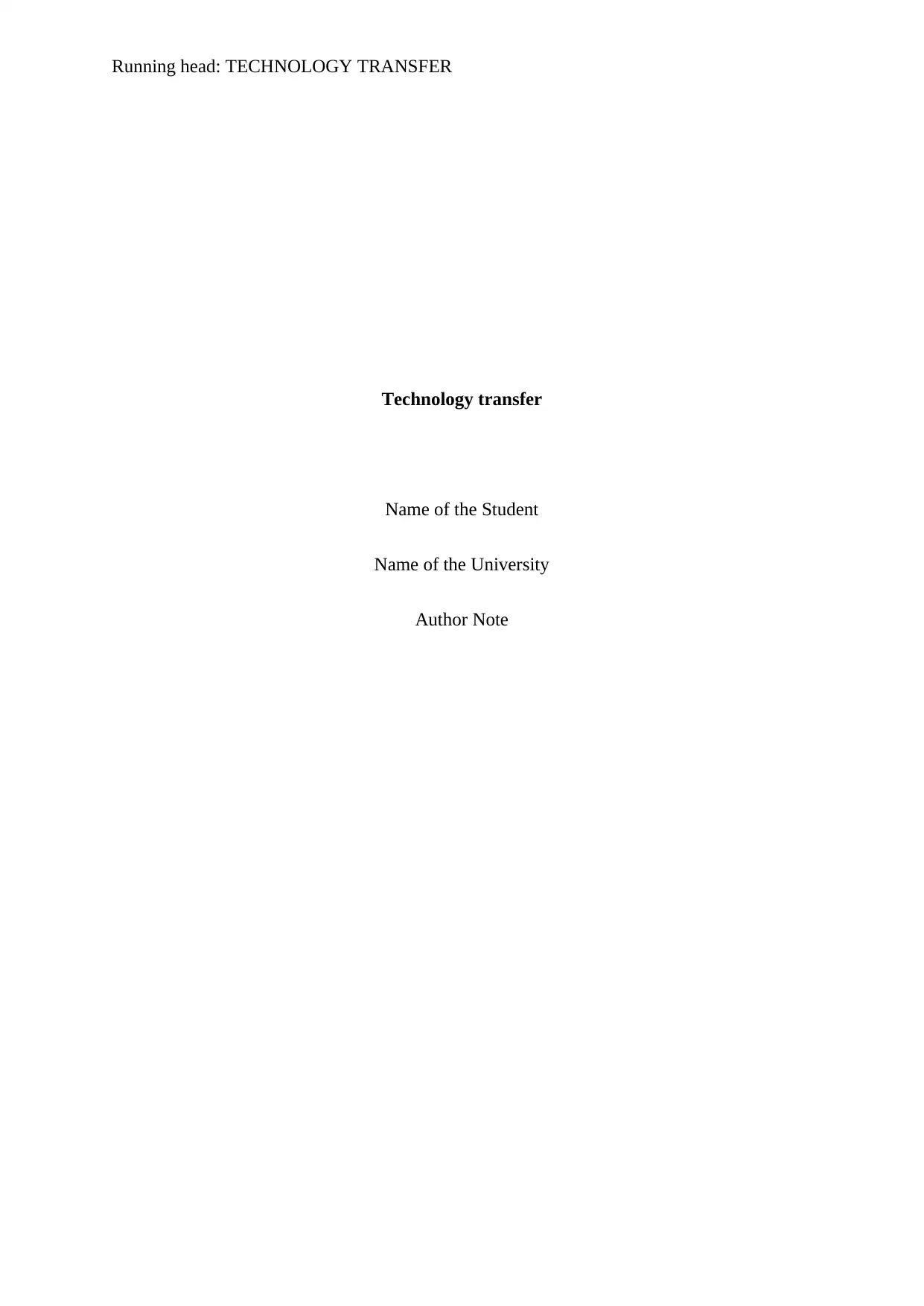
Running head: TECHNOLOGY TRANSFER
Technology transfer
Name of the Student
Name of the University
Author Note
Technology transfer
Name of the Student
Name of the University
Author Note
Secure Best Marks with AI Grader
Need help grading? Try our AI Grader for instant feedback on your assignments.
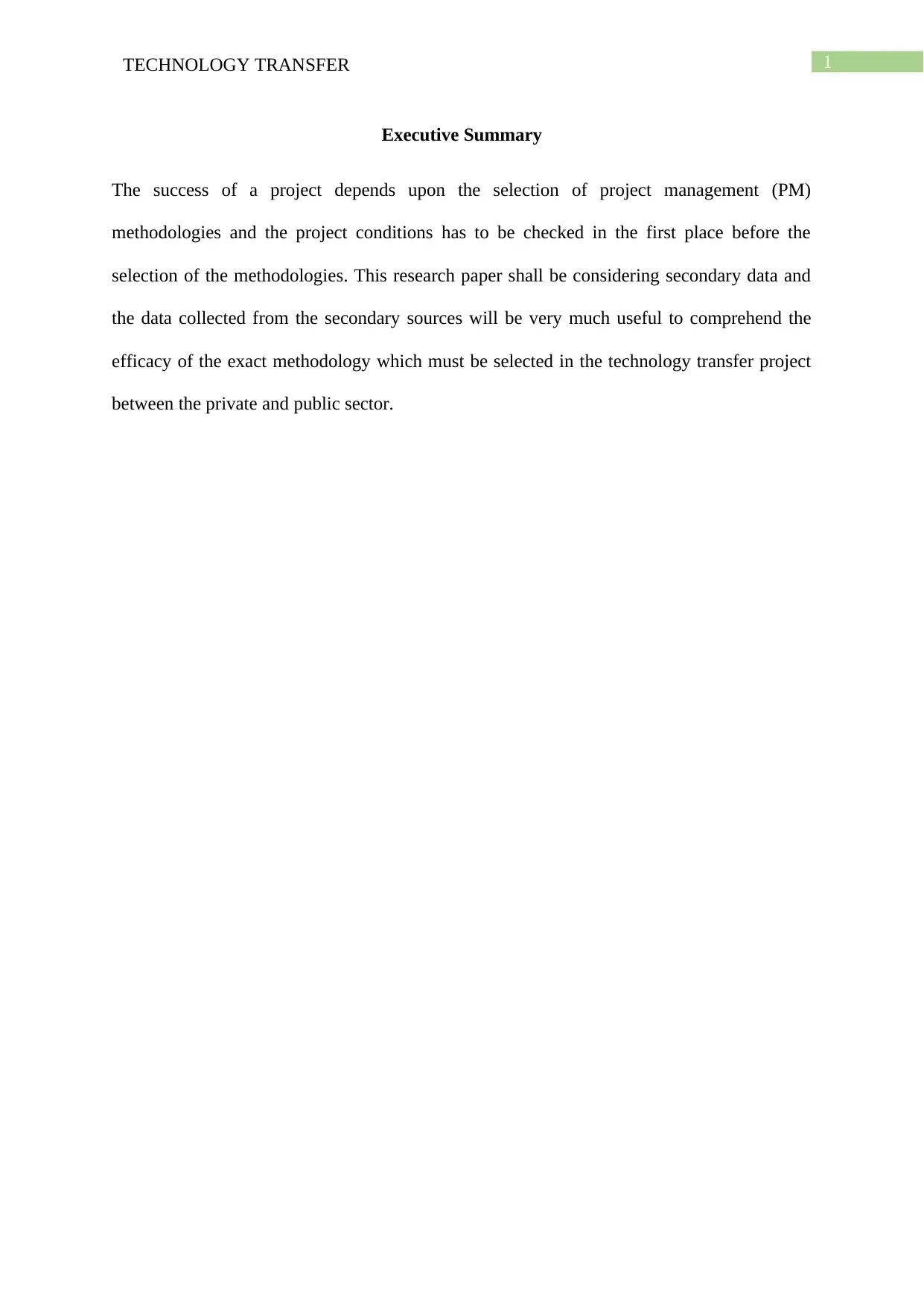
1TECHNOLOGY TRANSFER
Executive Summary
The success of a project depends upon the selection of project management (PM)
methodologies and the project conditions has to be checked in the first place before the
selection of the methodologies. This research paper shall be considering secondary data and
the data collected from the secondary sources will be very much useful to comprehend the
efficacy of the exact methodology which must be selected in the technology transfer project
between the private and public sector.
Executive Summary
The success of a project depends upon the selection of project management (PM)
methodologies and the project conditions has to be checked in the first place before the
selection of the methodologies. This research paper shall be considering secondary data and
the data collected from the secondary sources will be very much useful to comprehend the
efficacy of the exact methodology which must be selected in the technology transfer project
between the private and public sector.
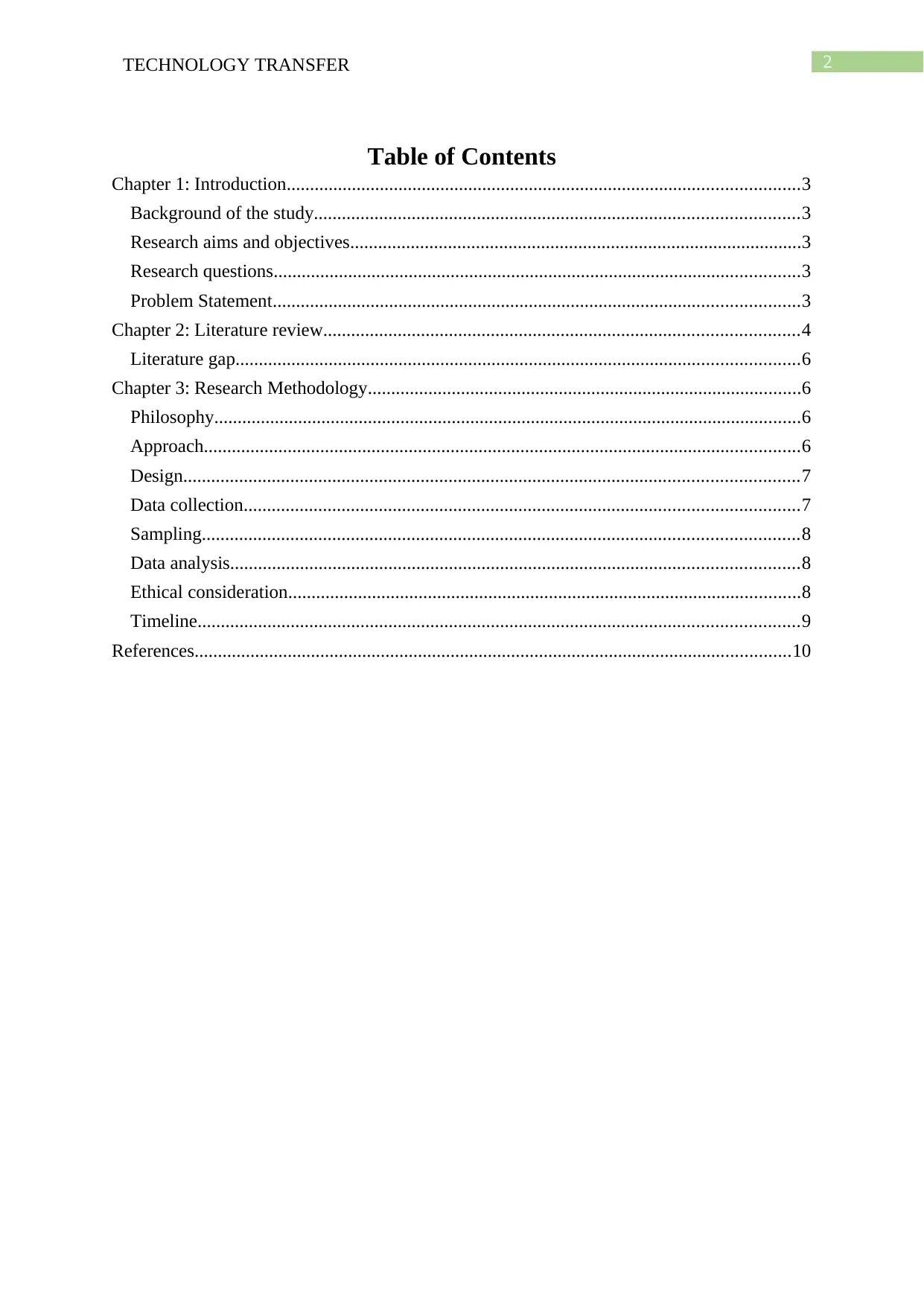
2TECHNOLOGY TRANSFER
Table of Contents
Chapter 1: Introduction..............................................................................................................3
Background of the study........................................................................................................3
Research aims and objectives.................................................................................................3
Research questions.................................................................................................................3
Problem Statement.................................................................................................................3
Chapter 2: Literature review......................................................................................................4
Literature gap.........................................................................................................................6
Chapter 3: Research Methodology.............................................................................................6
Philosophy..............................................................................................................................6
Approach................................................................................................................................6
Design....................................................................................................................................7
Data collection.......................................................................................................................7
Sampling................................................................................................................................8
Data analysis..........................................................................................................................8
Ethical consideration..............................................................................................................8
Timeline.................................................................................................................................9
References................................................................................................................................10
Table of Contents
Chapter 1: Introduction..............................................................................................................3
Background of the study........................................................................................................3
Research aims and objectives.................................................................................................3
Research questions.................................................................................................................3
Problem Statement.................................................................................................................3
Chapter 2: Literature review......................................................................................................4
Literature gap.........................................................................................................................6
Chapter 3: Research Methodology.............................................................................................6
Philosophy..............................................................................................................................6
Approach................................................................................................................................6
Design....................................................................................................................................7
Data collection.......................................................................................................................7
Sampling................................................................................................................................8
Data analysis..........................................................................................................................8
Ethical consideration..............................................................................................................8
Timeline.................................................................................................................................9
References................................................................................................................................10
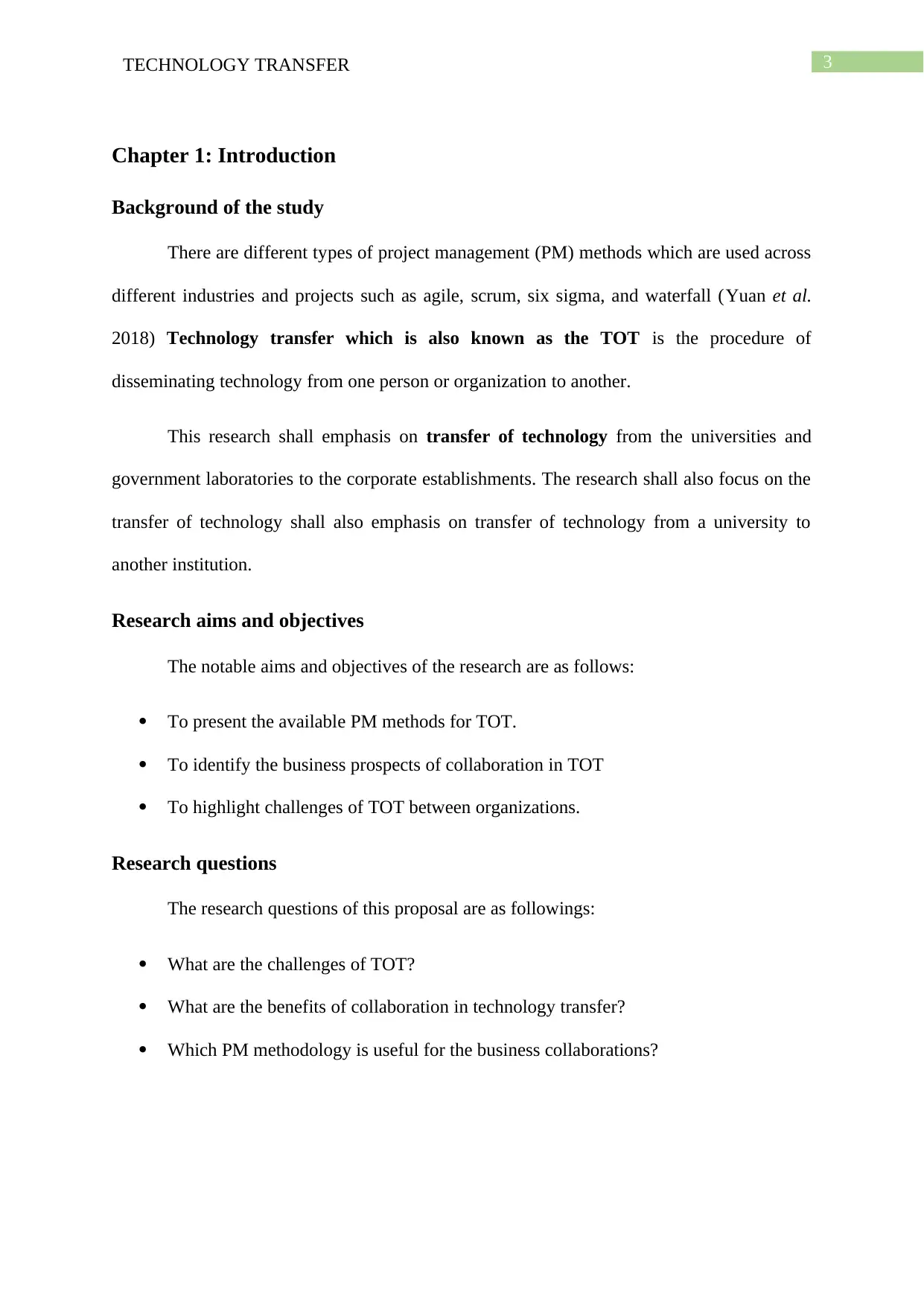
3TECHNOLOGY TRANSFER
Chapter 1: Introduction
Background of the study
There are different types of project management (PM) methods which are used across
different industries and projects such as agile, scrum, six sigma, and waterfall (Yuan et al.
2018) Technology transfer which is also known as the TOT is the procedure of
disseminating technology from one person or organization to another.
This research shall emphasis on transfer of technology from the universities and
government laboratories to the corporate establishments. The research shall also focus on the
transfer of technology shall also emphasis on transfer of technology from a university to
another institution.
Research aims and objectives
The notable aims and objectives of the research are as follows:
To present the available PM methods for TOT.
To identify the business prospects of collaboration in TOT
To highlight challenges of TOT between organizations.
Research questions
The research questions of this proposal are as followings:
What are the challenges of TOT?
What are the benefits of collaboration in technology transfer?
Which PM methodology is useful for the business collaborations?
Chapter 1: Introduction
Background of the study
There are different types of project management (PM) methods which are used across
different industries and projects such as agile, scrum, six sigma, and waterfall (Yuan et al.
2018) Technology transfer which is also known as the TOT is the procedure of
disseminating technology from one person or organization to another.
This research shall emphasis on transfer of technology from the universities and
government laboratories to the corporate establishments. The research shall also focus on the
transfer of technology shall also emphasis on transfer of technology from a university to
another institution.
Research aims and objectives
The notable aims and objectives of the research are as follows:
To present the available PM methods for TOT.
To identify the business prospects of collaboration in TOT
To highlight challenges of TOT between organizations.
Research questions
The research questions of this proposal are as followings:
What are the challenges of TOT?
What are the benefits of collaboration in technology transfer?
Which PM methodology is useful for the business collaborations?
Secure Best Marks with AI Grader
Need help grading? Try our AI Grader for instant feedback on your assignments.
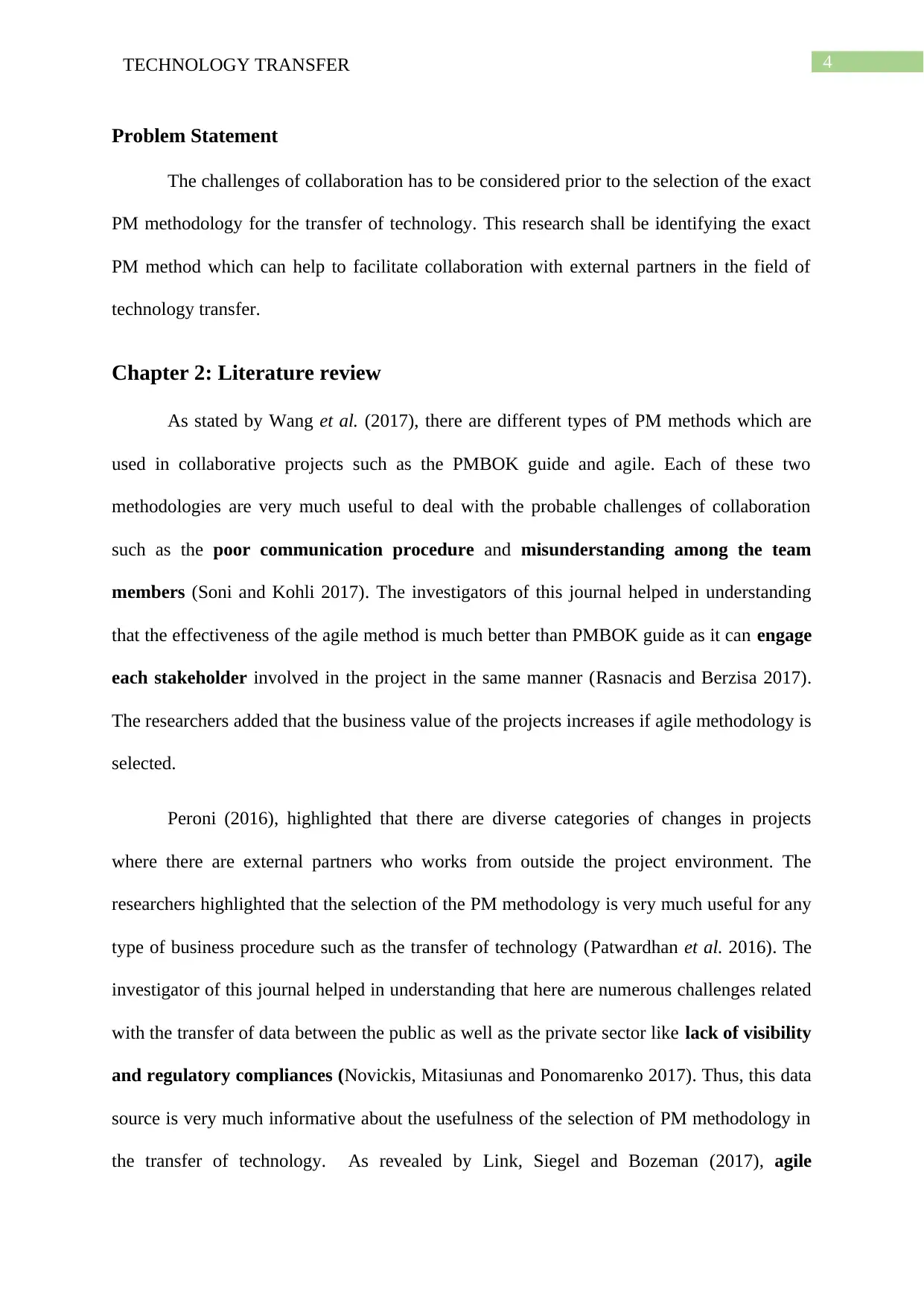
4TECHNOLOGY TRANSFER
Problem Statement
The challenges of collaboration has to be considered prior to the selection of the exact
PM methodology for the transfer of technology. This research shall be identifying the exact
PM method which can help to facilitate collaboration with external partners in the field of
technology transfer.
Chapter 2: Literature review
As stated by Wang et al. (2017), there are different types of PM methods which are
used in collaborative projects such as the PMBOK guide and agile. Each of these two
methodologies are very much useful to deal with the probable challenges of collaboration
such as the poor communication procedure and misunderstanding among the team
members (Soni and Kohli 2017). The investigators of this journal helped in understanding
that the effectiveness of the agile method is much better than PMBOK guide as it can engage
each stakeholder involved in the project in the same manner (Rasnacis and Berzisa 2017).
The researchers added that the business value of the projects increases if agile methodology is
selected.
Peroni (2016), highlighted that there are diverse categories of changes in projects
where there are external partners who works from outside the project environment. The
researchers highlighted that the selection of the PM methodology is very much useful for any
type of business procedure such as the transfer of technology (Patwardhan et al. 2016). The
investigator of this journal helped in understanding that here are numerous challenges related
with the transfer of data between the public as well as the private sector like lack of visibility
and regulatory compliances (Novickis, Mitasiunas and Ponomarenko 2017). Thus, this data
source is very much informative about the usefulness of the selection of PM methodology in
the transfer of technology. As revealed by Link, Siegel and Bozeman (2017), agile
Problem Statement
The challenges of collaboration has to be considered prior to the selection of the exact
PM methodology for the transfer of technology. This research shall be identifying the exact
PM method which can help to facilitate collaboration with external partners in the field of
technology transfer.
Chapter 2: Literature review
As stated by Wang et al. (2017), there are different types of PM methods which are
used in collaborative projects such as the PMBOK guide and agile. Each of these two
methodologies are very much useful to deal with the probable challenges of collaboration
such as the poor communication procedure and misunderstanding among the team
members (Soni and Kohli 2017). The investigators of this journal helped in understanding
that the effectiveness of the agile method is much better than PMBOK guide as it can engage
each stakeholder involved in the project in the same manner (Rasnacis and Berzisa 2017).
The researchers added that the business value of the projects increases if agile methodology is
selected.
Peroni (2016), highlighted that there are diverse categories of changes in projects
where there are external partners who works from outside the project environment. The
researchers highlighted that the selection of the PM methodology is very much useful for any
type of business procedure such as the transfer of technology (Patwardhan et al. 2016). The
investigator of this journal helped in understanding that here are numerous challenges related
with the transfer of data between the public as well as the private sector like lack of visibility
and regulatory compliances (Novickis, Mitasiunas and Ponomarenko 2017). Thus, this data
source is very much informative about the usefulness of the selection of PM methodology in
the transfer of technology. As revealed by Link, Siegel and Bozeman (2017), agile
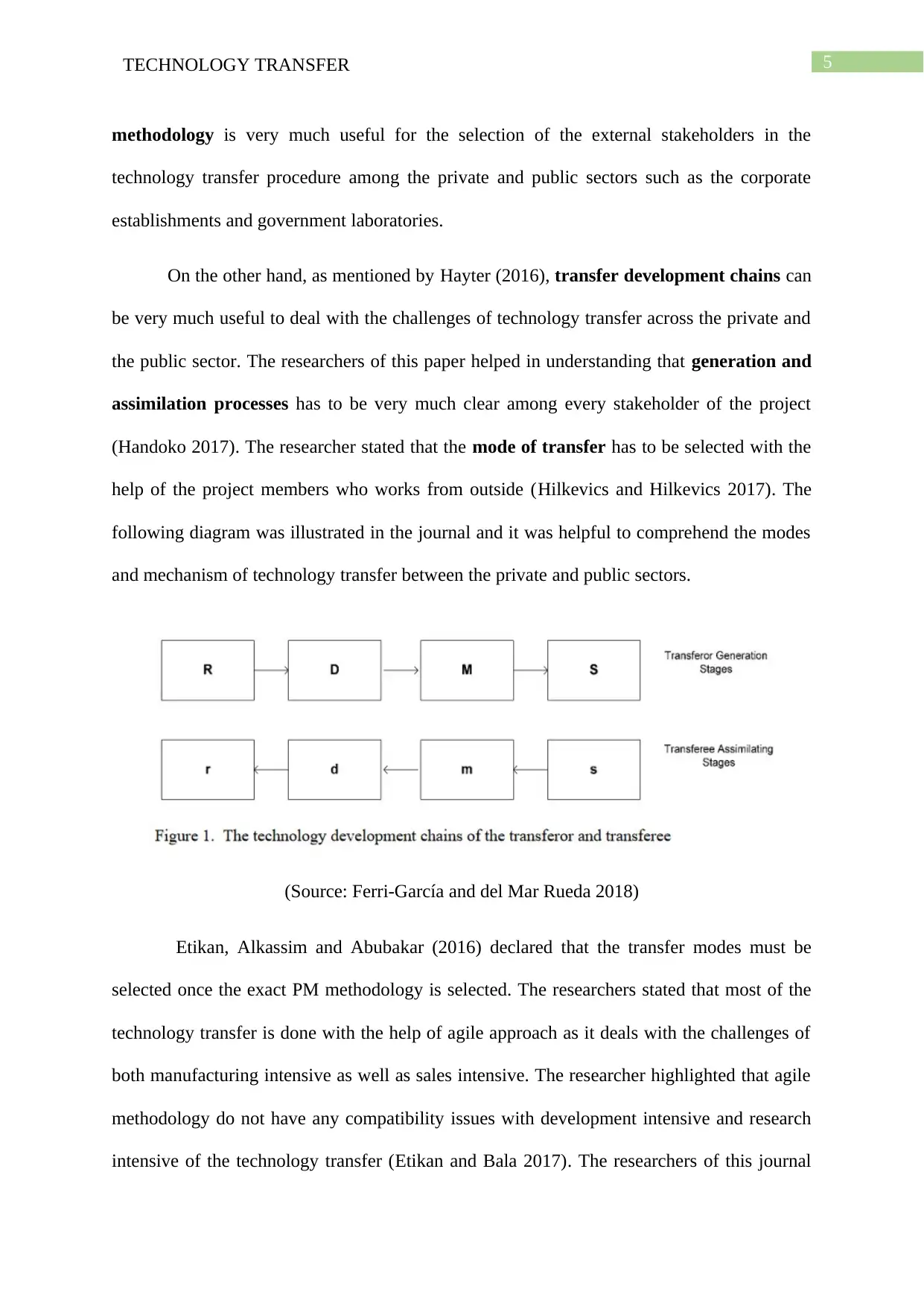
5TECHNOLOGY TRANSFER
methodology is very much useful for the selection of the external stakeholders in the
technology transfer procedure among the private and public sectors such as the corporate
establishments and government laboratories.
On the other hand, as mentioned by Hayter (2016), transfer development chains can
be very much useful to deal with the challenges of technology transfer across the private and
the public sector. The researchers of this paper helped in understanding that generation and
assimilation processes has to be very much clear among every stakeholder of the project
(Handoko 2017). The researcher stated that the mode of transfer has to be selected with the
help of the project members who works from outside (Hilkevics and Hilkevics 2017). The
following diagram was illustrated in the journal and it was helpful to comprehend the modes
and mechanism of technology transfer between the private and public sectors.
(Source: Ferri-García and del Mar Rueda 2018)
Etikan, Alkassim and Abubakar (2016) declared that the transfer modes must be
selected once the exact PM methodology is selected. The researchers stated that most of the
technology transfer is done with the help of agile approach as it deals with the challenges of
both manufacturing intensive as well as sales intensive. The researcher highlighted that agile
methodology do not have any compatibility issues with development intensive and research
intensive of the technology transfer (Etikan and Bala 2017). The researchers of this journal
methodology is very much useful for the selection of the external stakeholders in the
technology transfer procedure among the private and public sectors such as the corporate
establishments and government laboratories.
On the other hand, as mentioned by Hayter (2016), transfer development chains can
be very much useful to deal with the challenges of technology transfer across the private and
the public sector. The researchers of this paper helped in understanding that generation and
assimilation processes has to be very much clear among every stakeholder of the project
(Handoko 2017). The researcher stated that the mode of transfer has to be selected with the
help of the project members who works from outside (Hilkevics and Hilkevics 2017). The
following diagram was illustrated in the journal and it was helpful to comprehend the modes
and mechanism of technology transfer between the private and public sectors.
(Source: Ferri-García and del Mar Rueda 2018)
Etikan, Alkassim and Abubakar (2016) declared that the transfer modes must be
selected once the exact PM methodology is selected. The researchers stated that most of the
technology transfer is done with the help of agile approach as it deals with the challenges of
both manufacturing intensive as well as sales intensive. The researcher highlighted that agile
methodology do not have any compatibility issues with development intensive and research
intensive of the technology transfer (Etikan and Bala 2017). The researchers of this journal
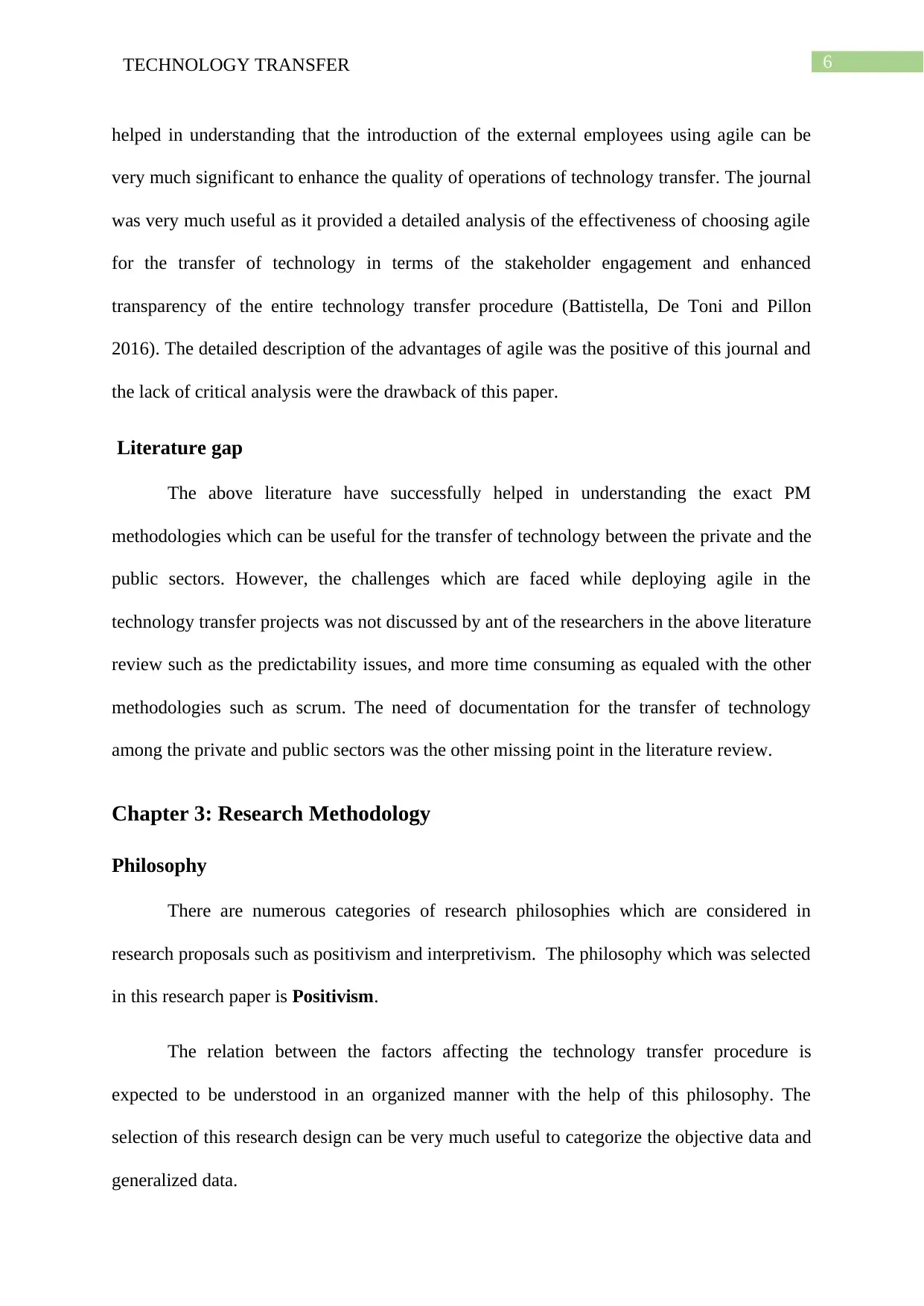
6TECHNOLOGY TRANSFER
helped in understanding that the introduction of the external employees using agile can be
very much significant to enhance the quality of operations of technology transfer. The journal
was very much useful as it provided a detailed analysis of the effectiveness of choosing agile
for the transfer of technology in terms of the stakeholder engagement and enhanced
transparency of the entire technology transfer procedure (Battistella, De Toni and Pillon
2016). The detailed description of the advantages of agile was the positive of this journal and
the lack of critical analysis were the drawback of this paper.
Literature gap
The above literature have successfully helped in understanding the exact PM
methodologies which can be useful for the transfer of technology between the private and the
public sectors. However, the challenges which are faced while deploying agile in the
technology transfer projects was not discussed by ant of the researchers in the above literature
review such as the predictability issues, and more time consuming as equaled with the other
methodologies such as scrum. The need of documentation for the transfer of technology
among the private and public sectors was the other missing point in the literature review.
Chapter 3: Research Methodology
Philosophy
There are numerous categories of research philosophies which are considered in
research proposals such as positivism and interpretivism. The philosophy which was selected
in this research paper is Positivism.
The relation between the factors affecting the technology transfer procedure is
expected to be understood in an organized manner with the help of this philosophy. The
selection of this research design can be very much useful to categorize the objective data and
generalized data.
helped in understanding that the introduction of the external employees using agile can be
very much significant to enhance the quality of operations of technology transfer. The journal
was very much useful as it provided a detailed analysis of the effectiveness of choosing agile
for the transfer of technology in terms of the stakeholder engagement and enhanced
transparency of the entire technology transfer procedure (Battistella, De Toni and Pillon
2016). The detailed description of the advantages of agile was the positive of this journal and
the lack of critical analysis were the drawback of this paper.
Literature gap
The above literature have successfully helped in understanding the exact PM
methodologies which can be useful for the transfer of technology between the private and the
public sectors. However, the challenges which are faced while deploying agile in the
technology transfer projects was not discussed by ant of the researchers in the above literature
review such as the predictability issues, and more time consuming as equaled with the other
methodologies such as scrum. The need of documentation for the transfer of technology
among the private and public sectors was the other missing point in the literature review.
Chapter 3: Research Methodology
Philosophy
There are numerous categories of research philosophies which are considered in
research proposals such as positivism and interpretivism. The philosophy which was selected
in this research paper is Positivism.
The relation between the factors affecting the technology transfer procedure is
expected to be understood in an organized manner with the help of this philosophy. The
selection of this research design can be very much useful to categorize the objective data and
generalized data.
Paraphrase This Document
Need a fresh take? Get an instant paraphrase of this document with our AI Paraphraser
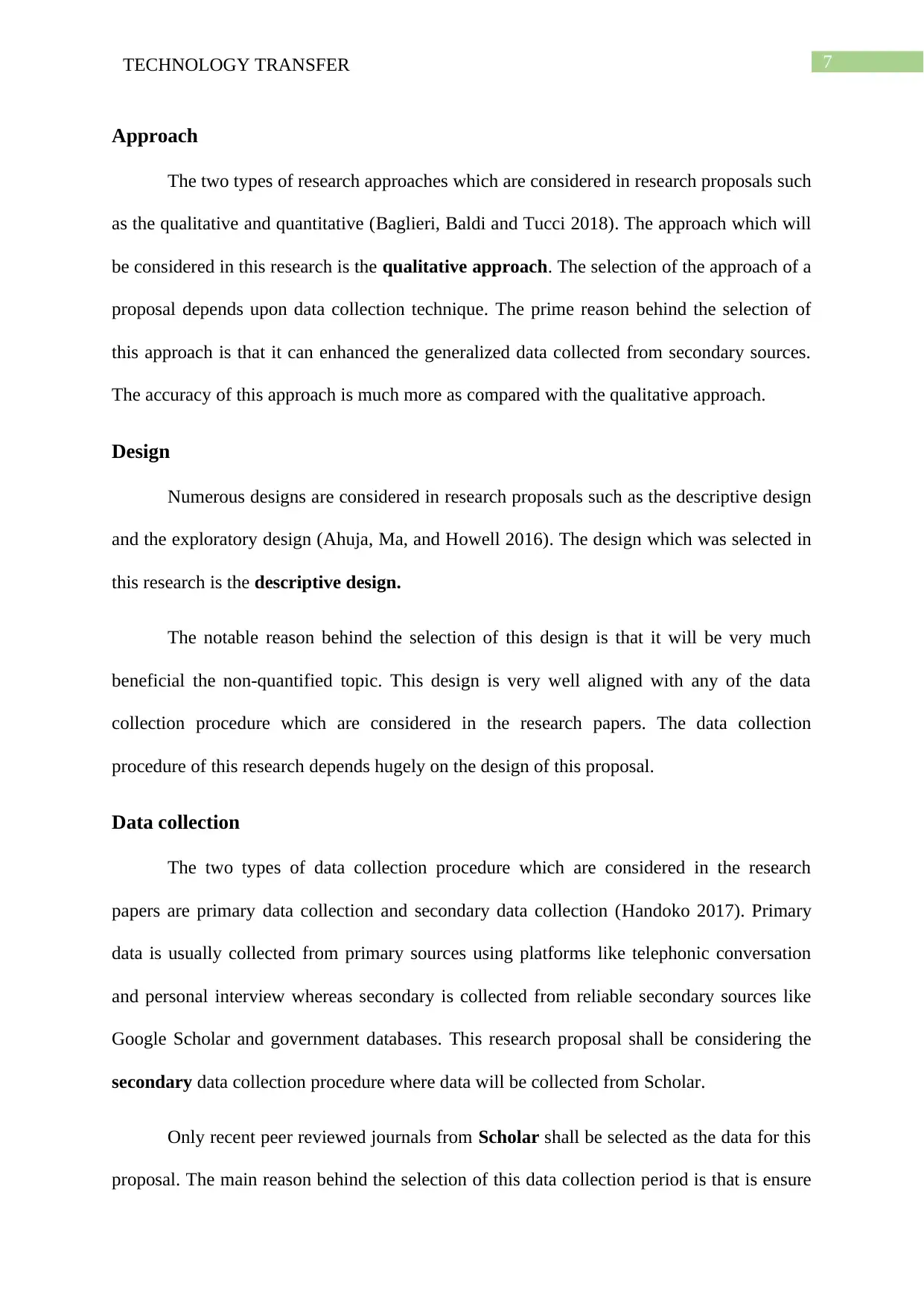
7TECHNOLOGY TRANSFER
Approach
The two types of research approaches which are considered in research proposals such
as the qualitative and quantitative (Baglieri, Baldi and Tucci 2018). The approach which will
be considered in this research is the qualitative approach. The selection of the approach of a
proposal depends upon data collection technique. The prime reason behind the selection of
this approach is that it can enhanced the generalized data collected from secondary sources.
The accuracy of this approach is much more as compared with the qualitative approach.
Design
Numerous designs are considered in research proposals such as the descriptive design
and the exploratory design (Ahuja, Ma, and Howell 2016). The design which was selected in
this research is the descriptive design.
The notable reason behind the selection of this design is that it will be very much
beneficial the non-quantified topic. This design is very well aligned with any of the data
collection procedure which are considered in the research papers. The data collection
procedure of this research depends hugely on the design of this proposal.
Data collection
The two types of data collection procedure which are considered in the research
papers are primary data collection and secondary data collection (Handoko 2017). Primary
data is usually collected from primary sources using platforms like telephonic conversation
and personal interview whereas secondary is collected from reliable secondary sources like
Google Scholar and government databases. This research proposal shall be considering the
secondary data collection procedure where data will be collected from Scholar.
Only recent peer reviewed journals from Scholar shall be selected as the data for this
proposal. The main reason behind the selection of this data collection period is that is ensure
Approach
The two types of research approaches which are considered in research proposals such
as the qualitative and quantitative (Baglieri, Baldi and Tucci 2018). The approach which will
be considered in this research is the qualitative approach. The selection of the approach of a
proposal depends upon data collection technique. The prime reason behind the selection of
this approach is that it can enhanced the generalized data collected from secondary sources.
The accuracy of this approach is much more as compared with the qualitative approach.
Design
Numerous designs are considered in research proposals such as the descriptive design
and the exploratory design (Ahuja, Ma, and Howell 2016). The design which was selected in
this research is the descriptive design.
The notable reason behind the selection of this design is that it will be very much
beneficial the non-quantified topic. This design is very well aligned with any of the data
collection procedure which are considered in the research papers. The data collection
procedure of this research depends hugely on the design of this proposal.
Data collection
The two types of data collection procedure which are considered in the research
papers are primary data collection and secondary data collection (Handoko 2017). Primary
data is usually collected from primary sources using platforms like telephonic conversation
and personal interview whereas secondary is collected from reliable secondary sources like
Google Scholar and government databases. This research proposal shall be considering the
secondary data collection procedure where data will be collected from Scholar.
Only recent peer reviewed journals from Scholar shall be selected as the data for this
proposal. The main reason behind the selection of this data collection period is that is ensure
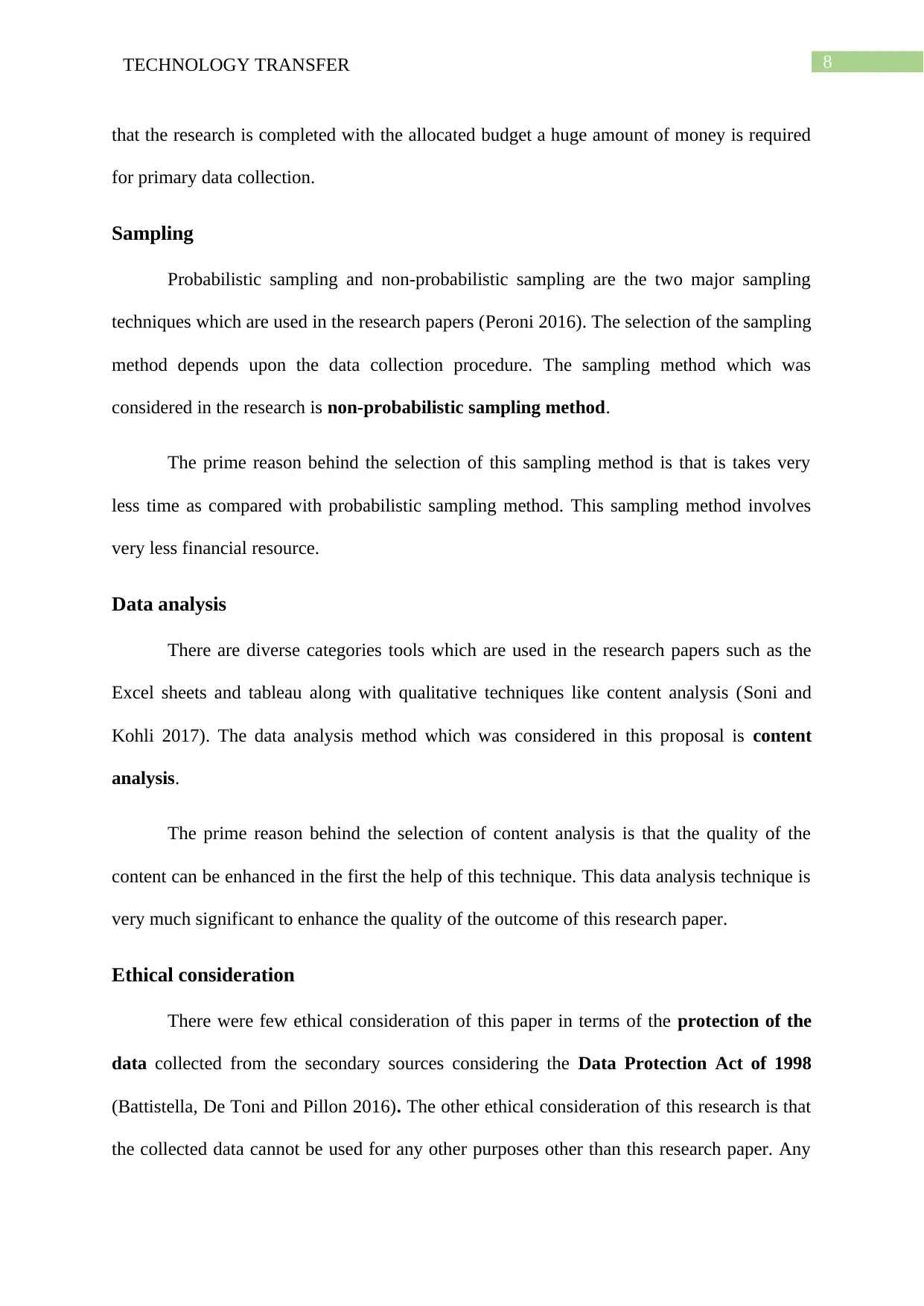
8TECHNOLOGY TRANSFER
that the research is completed with the allocated budget a huge amount of money is required
for primary data collection.
Sampling
Probabilistic sampling and non-probabilistic sampling are the two major sampling
techniques which are used in the research papers (Peroni 2016). The selection of the sampling
method depends upon the data collection procedure. The sampling method which was
considered in the research is non-probabilistic sampling method.
The prime reason behind the selection of this sampling method is that is takes very
less time as compared with probabilistic sampling method. This sampling method involves
very less financial resource.
Data analysis
There are diverse categories tools which are used in the research papers such as the
Excel sheets and tableau along with qualitative techniques like content analysis (Soni and
Kohli 2017). The data analysis method which was considered in this proposal is content
analysis.
The prime reason behind the selection of content analysis is that the quality of the
content can be enhanced in the first the help of this technique. This data analysis technique is
very much significant to enhance the quality of the outcome of this research paper.
Ethical consideration
There were few ethical consideration of this paper in terms of the protection of the
data collected from the secondary sources considering the Data Protection Act of 1998
(Battistella, De Toni and Pillon 2016). The other ethical consideration of this research is that
the collected data cannot be used for any other purposes other than this research paper. Any
that the research is completed with the allocated budget a huge amount of money is required
for primary data collection.
Sampling
Probabilistic sampling and non-probabilistic sampling are the two major sampling
techniques which are used in the research papers (Peroni 2016). The selection of the sampling
method depends upon the data collection procedure. The sampling method which was
considered in the research is non-probabilistic sampling method.
The prime reason behind the selection of this sampling method is that is takes very
less time as compared with probabilistic sampling method. This sampling method involves
very less financial resource.
Data analysis
There are diverse categories tools which are used in the research papers such as the
Excel sheets and tableau along with qualitative techniques like content analysis (Soni and
Kohli 2017). The data analysis method which was considered in this proposal is content
analysis.
The prime reason behind the selection of content analysis is that the quality of the
content can be enhanced in the first the help of this technique. This data analysis technique is
very much significant to enhance the quality of the outcome of this research paper.
Ethical consideration
There were few ethical consideration of this paper in terms of the protection of the
data collected from the secondary sources considering the Data Protection Act of 1998
(Battistella, De Toni and Pillon 2016). The other ethical consideration of this research is that
the collected data cannot be used for any other purposes other than this research paper. Any
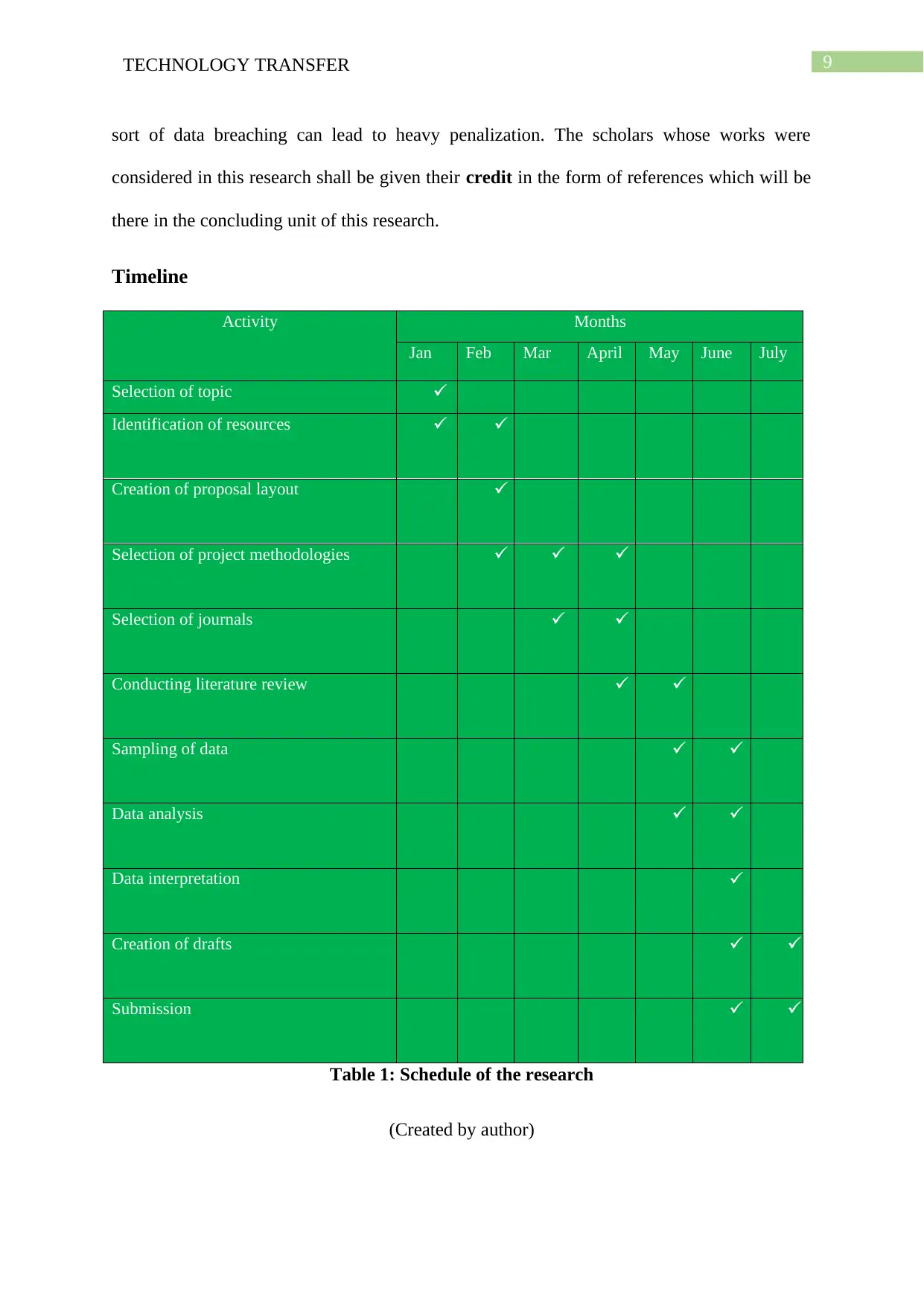
9TECHNOLOGY TRANSFER
sort of data breaching can lead to heavy penalization. The scholars whose works were
considered in this research shall be given their credit in the form of references which will be
there in the concluding unit of this research.
Timeline
Activity Months
Jan Feb Mar April May June July
Selection of topic
Identification of resources
Creation of proposal layout
Selection of project methodologies
Selection of journals
Conducting literature review
Sampling of data
Data analysis
Data interpretation
Creation of drafts
Submission
Table 1: Schedule of the research
(Created by author)
sort of data breaching can lead to heavy penalization. The scholars whose works were
considered in this research shall be given their credit in the form of references which will be
there in the concluding unit of this research.
Timeline
Activity Months
Jan Feb Mar April May June July
Selection of topic
Identification of resources
Creation of proposal layout
Selection of project methodologies
Selection of journals
Conducting literature review
Sampling of data
Data analysis
Data interpretation
Creation of drafts
Submission
Table 1: Schedule of the research
(Created by author)
Secure Best Marks with AI Grader
Need help grading? Try our AI Grader for instant feedback on your assignments.

10TECHNOLOGY TRANSFER
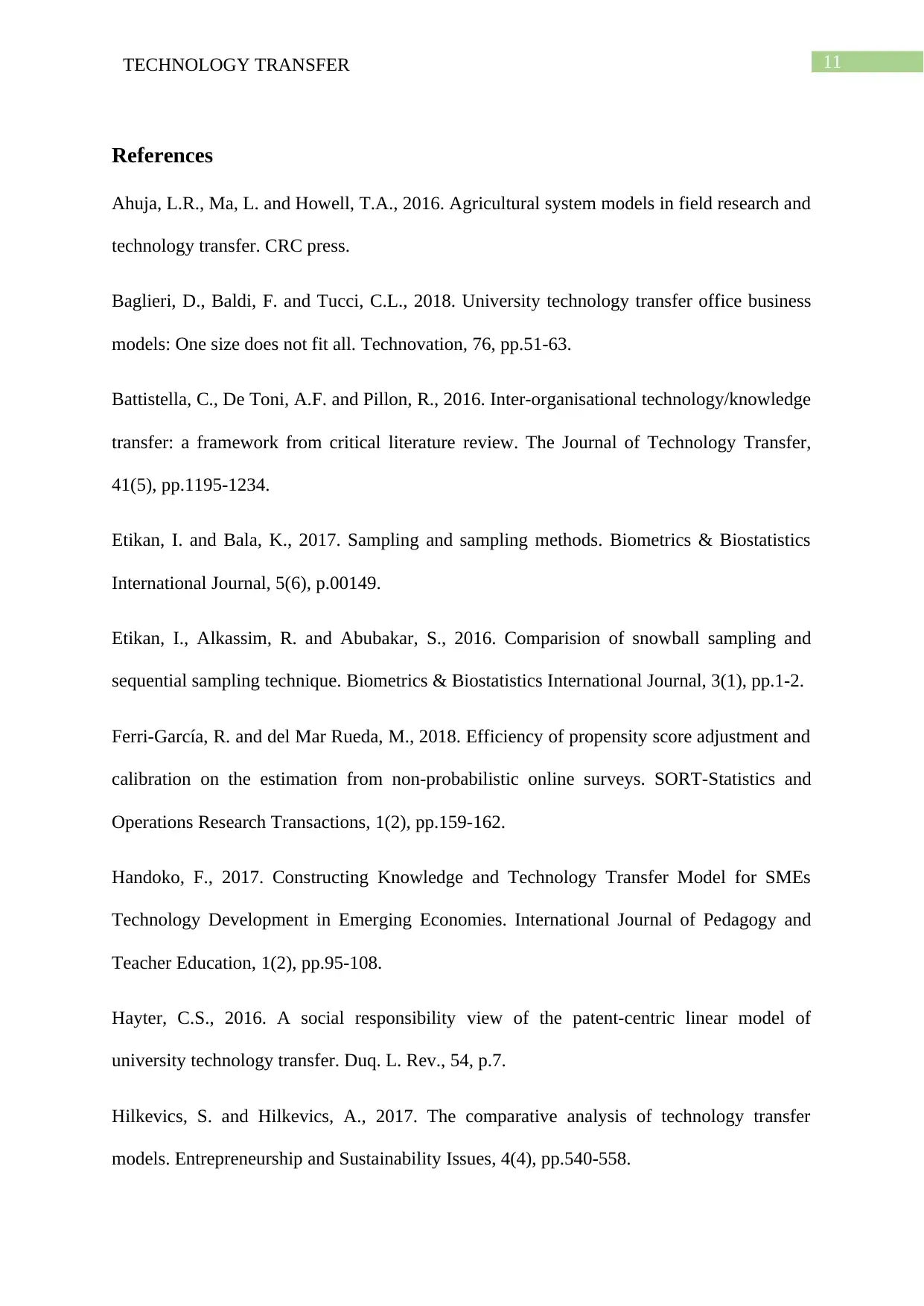
11TECHNOLOGY TRANSFER
References
Ahuja, L.R., Ma, L. and Howell, T.A., 2016. Agricultural system models in field research and
technology transfer. CRC press.
Baglieri, D., Baldi, F. and Tucci, C.L., 2018. University technology transfer office business
models: One size does not fit all. Technovation, 76, pp.51-63.
Battistella, C., De Toni, A.F. and Pillon, R., 2016. Inter-organisational technology/knowledge
transfer: a framework from critical literature review. The Journal of Technology Transfer,
41(5), pp.1195-1234.
Etikan, I. and Bala, K., 2017. Sampling and sampling methods. Biometrics & Biostatistics
International Journal, 5(6), p.00149.
Etikan, I., Alkassim, R. and Abubakar, S., 2016. Comparision of snowball sampling and
sequential sampling technique. Biometrics & Biostatistics International Journal, 3(1), pp.1-2.
Ferri-García, R. and del Mar Rueda, M., 2018. Efficiency of propensity score adjustment and
calibration on the estimation from non-probabilistic online surveys. SORT-Statistics and
Operations Research Transactions, 1(2), pp.159-162.
Handoko, F., 2017. Constructing Knowledge and Technology Transfer Model for SMEs
Technology Development in Emerging Economies. International Journal of Pedagogy and
Teacher Education, 1(2), pp.95-108.
Hayter, C.S., 2016. A social responsibility view of the patent-centric linear model of
university technology transfer. Duq. L. Rev., 54, p.7.
Hilkevics, S. and Hilkevics, A., 2017. The comparative analysis of technology transfer
models. Entrepreneurship and Sustainability Issues, 4(4), pp.540-558.
References
Ahuja, L.R., Ma, L. and Howell, T.A., 2016. Agricultural system models in field research and
technology transfer. CRC press.
Baglieri, D., Baldi, F. and Tucci, C.L., 2018. University technology transfer office business
models: One size does not fit all. Technovation, 76, pp.51-63.
Battistella, C., De Toni, A.F. and Pillon, R., 2016. Inter-organisational technology/knowledge
transfer: a framework from critical literature review. The Journal of Technology Transfer,
41(5), pp.1195-1234.
Etikan, I. and Bala, K., 2017. Sampling and sampling methods. Biometrics & Biostatistics
International Journal, 5(6), p.00149.
Etikan, I., Alkassim, R. and Abubakar, S., 2016. Comparision of snowball sampling and
sequential sampling technique. Biometrics & Biostatistics International Journal, 3(1), pp.1-2.
Ferri-García, R. and del Mar Rueda, M., 2018. Efficiency of propensity score adjustment and
calibration on the estimation from non-probabilistic online surveys. SORT-Statistics and
Operations Research Transactions, 1(2), pp.159-162.
Handoko, F., 2017. Constructing Knowledge and Technology Transfer Model for SMEs
Technology Development in Emerging Economies. International Journal of Pedagogy and
Teacher Education, 1(2), pp.95-108.
Hayter, C.S., 2016. A social responsibility view of the patent-centric linear model of
university technology transfer. Duq. L. Rev., 54, p.7.
Hilkevics, S. and Hilkevics, A., 2017. The comparative analysis of technology transfer
models. Entrepreneurship and Sustainability Issues, 4(4), pp.540-558.
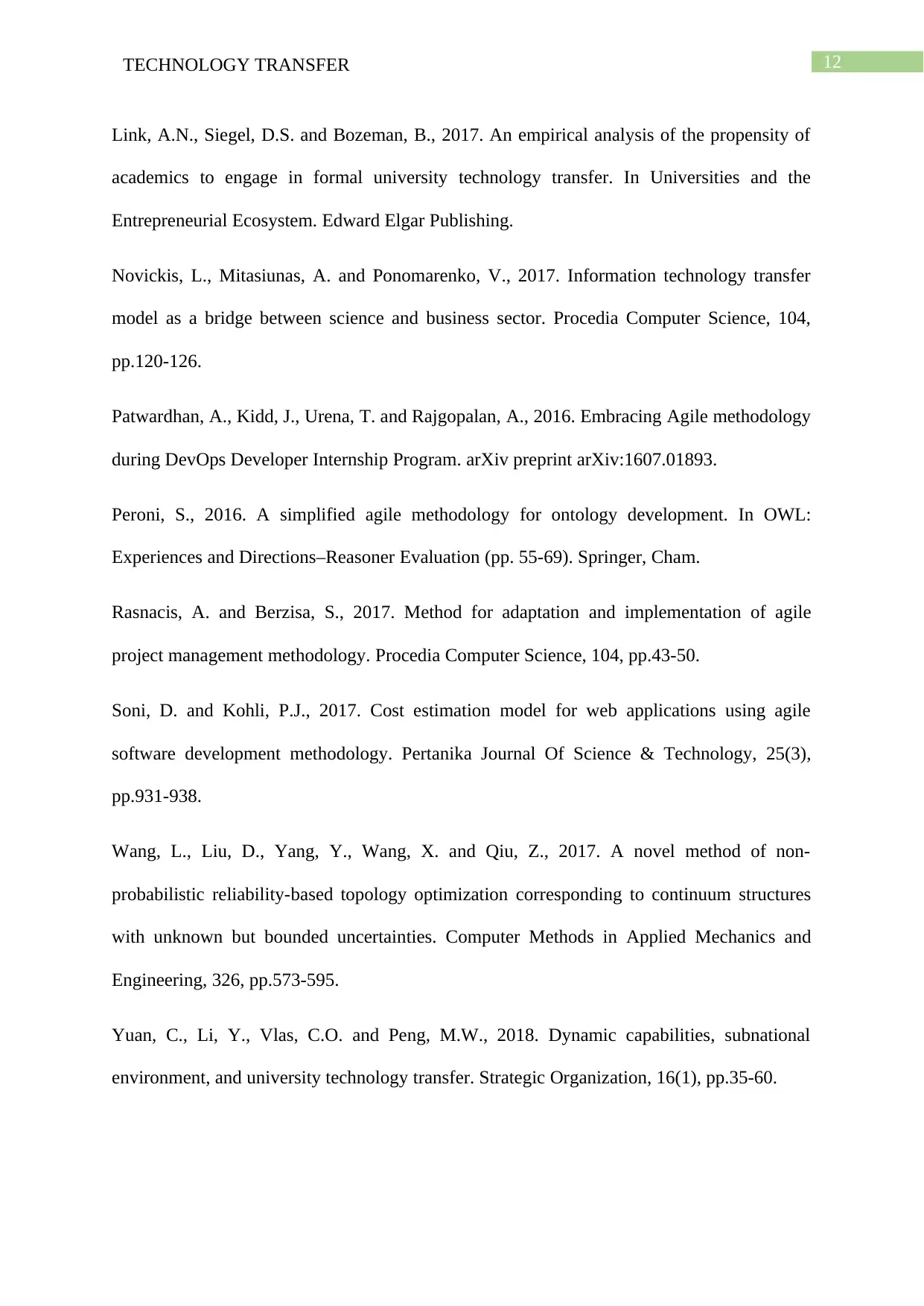
12TECHNOLOGY TRANSFER
Link, A.N., Siegel, D.S. and Bozeman, B., 2017. An empirical analysis of the propensity of
academics to engage in formal university technology transfer. In Universities and the
Entrepreneurial Ecosystem. Edward Elgar Publishing.
Novickis, L., Mitasiunas, A. and Ponomarenko, V., 2017. Information technology transfer
model as a bridge between science and business sector. Procedia Computer Science, 104,
pp.120-126.
Patwardhan, A., Kidd, J., Urena, T. and Rajgopalan, A., 2016. Embracing Agile methodology
during DevOps Developer Internship Program. arXiv preprint arXiv:1607.01893.
Peroni, S., 2016. A simplified agile methodology for ontology development. In OWL:
Experiences and Directions–Reasoner Evaluation (pp. 55-69). Springer, Cham.
Rasnacis, A. and Berzisa, S., 2017. Method for adaptation and implementation of agile
project management methodology. Procedia Computer Science, 104, pp.43-50.
Soni, D. and Kohli, P.J., 2017. Cost estimation model for web applications using agile
software development methodology. Pertanika Journal Of Science & Technology, 25(3),
pp.931-938.
Wang, L., Liu, D., Yang, Y., Wang, X. and Qiu, Z., 2017. A novel method of non-
probabilistic reliability-based topology optimization corresponding to continuum structures
with unknown but bounded uncertainties. Computer Methods in Applied Mechanics and
Engineering, 326, pp.573-595.
Yuan, C., Li, Y., Vlas, C.O. and Peng, M.W., 2018. Dynamic capabilities, subnational
environment, and university technology transfer. Strategic Organization, 16(1), pp.35-60.
Link, A.N., Siegel, D.S. and Bozeman, B., 2017. An empirical analysis of the propensity of
academics to engage in formal university technology transfer. In Universities and the
Entrepreneurial Ecosystem. Edward Elgar Publishing.
Novickis, L., Mitasiunas, A. and Ponomarenko, V., 2017. Information technology transfer
model as a bridge between science and business sector. Procedia Computer Science, 104,
pp.120-126.
Patwardhan, A., Kidd, J., Urena, T. and Rajgopalan, A., 2016. Embracing Agile methodology
during DevOps Developer Internship Program. arXiv preprint arXiv:1607.01893.
Peroni, S., 2016. A simplified agile methodology for ontology development. In OWL:
Experiences and Directions–Reasoner Evaluation (pp. 55-69). Springer, Cham.
Rasnacis, A. and Berzisa, S., 2017. Method for adaptation and implementation of agile
project management methodology. Procedia Computer Science, 104, pp.43-50.
Soni, D. and Kohli, P.J., 2017. Cost estimation model for web applications using agile
software development methodology. Pertanika Journal Of Science & Technology, 25(3),
pp.931-938.
Wang, L., Liu, D., Yang, Y., Wang, X. and Qiu, Z., 2017. A novel method of non-
probabilistic reliability-based topology optimization corresponding to continuum structures
with unknown but bounded uncertainties. Computer Methods in Applied Mechanics and
Engineering, 326, pp.573-595.
Yuan, C., Li, Y., Vlas, C.O. and Peng, M.W., 2018. Dynamic capabilities, subnational
environment, and university technology transfer. Strategic Organization, 16(1), pp.35-60.
1 out of 13
Related Documents
Your All-in-One AI-Powered Toolkit for Academic Success.
+13062052269
info@desklib.com
Available 24*7 on WhatsApp / Email
![[object Object]](/_next/static/media/star-bottom.7253800d.svg)
Unlock your academic potential
© 2024 | Zucol Services PVT LTD | All rights reserved.





